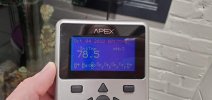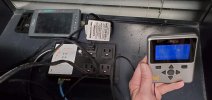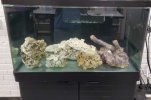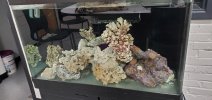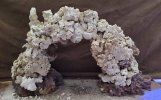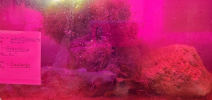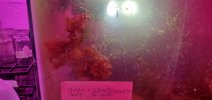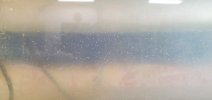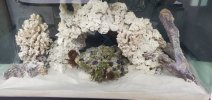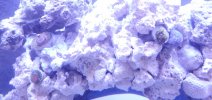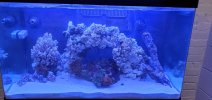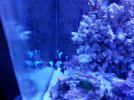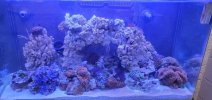Hi there fellow reefers! My name is Lisa Brown, and I teach at Davidson Fine Arts Magnet in Augusta, Georgia.
My husband (chemaholic) and I just got into reefing ourselves this summer when we acquired a 120 gallon setup (with livestock!) in June. We've learned so much from it, that I figured my students could too -- so I got permission to start a reef tank at school.
The tank we are starting with is a used Red Sea MAX 250 (purchased from an ARC member) with stand. Both circulation pumps were missing and the hood had no bulbs (fits 6 T5s), a damaged ballast, and corroded light cooling fans, but the skimmer worked! We are using a heater donated by ARC, but we had to purchase sponges, filter media, and the lens cover fasteners.
Here is a status update:
The tank cabinet was damaged upon the initial move to the school, so it took about a week to get it stabilized so it could hold 600 lbs! Thank goodness for the theater tech kids and their woodworking skills.
Three students in the Research class have chosen the reef tank as their project, so they were tasked with making the salt water. They are also learning about the auto top-off devices and the Klir Drop In Filter and how to operate them (those were donated by ARC).
On Wednesday, 8/17, all light bulbs had arrived as well as the lens cover fasteners. We didn't want to put any water in the tank until the light fixture was safe. The hood holds 6 T5 bulbs (2 Coral +, 2 Blue +, 1 Purple +, and 1 Super Actinic).

By Friday, 8/19, there was enough water to run the pumps over the weekend (don't worry -- it was filled up before the end of the day). The hood was raised, and the T5 lights were not run.

On Monday, 8/22, I brought a large live rock to place in the tank to start cycling. Visible hitchhikers included a Mexican cerith and a small Yuma. A small powerhead (ARC donation) was placed as well.


Unfortunately, a fatal error was made -- the lights were inadvertently left on all night. When I arrived to school, the water temperature was nearly 90 deg F, and there were dead bristleworms swirling around the bottom of the tank. The Yuma had turned nearly gelatinous.



We turned off the lights, removed the hood, and scooped out the dead worms (3 of which were actually alive!). By the time I left school on Tuesday at 4:30pm, the temperature was still around 82 deg F.
Apparently this is a known issue with this tank -- the excessive heat -- but it also didn't help that the water cooling fans weren't working. We desperately need a chiller!
On Wednesday 8/24, I replaced the hood, turned on the lights at 8am, and we monitored the temperature until 4pm when the lights were turned off. The temperature increased from 82 deg F to 88 deg F over the course of the day.
On Thursday 8/25, the temperature was 84 deg F this morning before the lights were turned on at 8am. The hood flap is open, as is the skimmer cover, but it is still getting too hot for life in that tank Although I did spot this guy today:
Although I did spot this guy today:
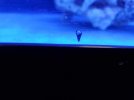
The aquascape (ARC donation and personal donation) is being designed and built by the sculpture students, and it should be ready by 9/1. We will put in the Fiji Pink and Bahamas Oolite substrate (ARC donation) after the aquascape is placed.
We have also placed a 10-gallon (ARC donation) tank, light (ARC donation) and powerhead/pump (ARC donation) in 3 different classrooms so we can grow macroalgae (we have a local donation of chaetomorpha on standby), phytoplankton, and copepods. The students will be examining changes in growth resulting from varied parameters (light duration, light color, nutrient supplements, etc) in addition to basic microscopic identification.
Slowly but surely, it's coming along. We welcome any and all suggestions and donations
PS: ARC did donate a large LED fixture that could potentially replace the T5s, but the conversion of the hood is expensive, and I am certain we would not get permission to hang it from the drop ceiling.
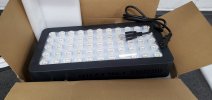
UPDATE 9/25/22:
We are still struggling with maintaining a viable tank temperature. We acquired a used chiller (1/4 hp Ecoplus) from a local reefer, but the chiller had a non-working internal thermostat. Since the school turns the AC off after 6pm, the temperature kept rising to 88 in the evenings, and the chiller never turned off, so it froze over and leaked all over the floor. We have a new chiller, but we are trying to figure out a way to monitor the temperature continually.
My husband (chemaholic) and I just got into reefing ourselves this summer when we acquired a 120 gallon setup (with livestock!) in June. We've learned so much from it, that I figured my students could too -- so I got permission to start a reef tank at school.
The tank we are starting with is a used Red Sea MAX 250 (purchased from an ARC member) with stand. Both circulation pumps were missing and the hood had no bulbs (fits 6 T5s), a damaged ballast, and corroded light cooling fans, but the skimmer worked! We are using a heater donated by ARC, but we had to purchase sponges, filter media, and the lens cover fasteners.
Here is a status update:
The tank cabinet was damaged upon the initial move to the school, so it took about a week to get it stabilized so it could hold 600 lbs! Thank goodness for the theater tech kids and their woodworking skills.
Three students in the Research class have chosen the reef tank as their project, so they were tasked with making the salt water. They are also learning about the auto top-off devices and the Klir Drop In Filter and how to operate them (those were donated by ARC).
On Wednesday, 8/17, all light bulbs had arrived as well as the lens cover fasteners. We didn't want to put any water in the tank until the light fixture was safe. The hood holds 6 T5 bulbs (2 Coral +, 2 Blue +, 1 Purple +, and 1 Super Actinic).
By Friday, 8/19, there was enough water to run the pumps over the weekend (don't worry -- it was filled up before the end of the day). The hood was raised, and the T5 lights were not run.
On Monday, 8/22, I brought a large live rock to place in the tank to start cycling. Visible hitchhikers included a Mexican cerith and a small Yuma. A small powerhead (ARC donation) was placed as well.
Unfortunately, a fatal error was made -- the lights were inadvertently left on all night. When I arrived to school, the water temperature was nearly 90 deg F, and there were dead bristleworms swirling around the bottom of the tank. The Yuma had turned nearly gelatinous.
We turned off the lights, removed the hood, and scooped out the dead worms (3 of which were actually alive!). By the time I left school on Tuesday at 4:30pm, the temperature was still around 82 deg F.
Apparently this is a known issue with this tank -- the excessive heat -- but it also didn't help that the water cooling fans weren't working. We desperately need a chiller!
On Wednesday 8/24, I replaced the hood, turned on the lights at 8am, and we monitored the temperature until 4pm when the lights were turned off. The temperature increased from 82 deg F to 88 deg F over the course of the day.
On Thursday 8/25, the temperature was 84 deg F this morning before the lights were turned on at 8am. The hood flap is open, as is the skimmer cover, but it is still getting too hot for life in that tank

The aquascape (ARC donation and personal donation) is being designed and built by the sculpture students, and it should be ready by 9/1. We will put in the Fiji Pink and Bahamas Oolite substrate (ARC donation) after the aquascape is placed.
We have also placed a 10-gallon (ARC donation) tank, light (ARC donation) and powerhead/pump (ARC donation) in 3 different classrooms so we can grow macroalgae (we have a local donation of chaetomorpha on standby), phytoplankton, and copepods. The students will be examining changes in growth resulting from varied parameters (light duration, light color, nutrient supplements, etc) in addition to basic microscopic identification.
Slowly but surely, it's coming along. We welcome any and all suggestions and donations
PS: ARC did donate a large LED fixture that could potentially replace the T5s, but the conversion of the hood is expensive, and I am certain we would not get permission to hang it from the drop ceiling.

UPDATE 9/25/22:
We are still struggling with maintaining a viable tank temperature. We acquired a used chiller (1/4 hp Ecoplus) from a local reefer, but the chiller had a non-working internal thermostat. Since the school turns the AC off after 6pm, the temperature kept rising to 88 in the evenings, and the chiller never turned off, so it froze over and leaked all over the floor. We have a new chiller, but we are trying to figure out a way to monitor the temperature continually.
Last edited:

